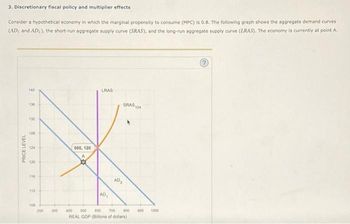
ENGR.ECONOMIC ANALYSIS
14th Edition
ISBN: 9780190931919
Author: NEWNAN
Publisher: Oxford University Press
expand_more
expand_more
format_list_bulleted
Question
am. 152.

Transcribed Image Text:3. Discretionary fiscal policy and multiplier effects
Consider a hypothetical economy in which the marginal propensity to consume (MPC) is 0.8. The following graph shows the aggregate demand curves
(AD and AD:), the short-run aggregate supply curve (SRAS), and the long-run aggregate supply curve (LRAS). The economy is currently at point A.
PRICE LEVEL
LRAS
140
130
SRAS24
120
8 8
132
124
120
116
112
100
200 300
400
500, 120
AD₂
AD
500
600
700
600
000
1000
REAL GDP (Billions of dollars);

Transcribed Image Text:The economy is currently experiencing an inflationary
gap of $
In order to close this gap, one option would be for the government to
taxes do not change).
If the government kept its purchases constant, it could also close the gap by
billion.
government purchases by $
billion (assuming net
net taxes by $
billion.
Expert Solution
This question has been solved!
Explore an expertly crafted, step-by-step solution for a thorough understanding of key concepts.
Step by stepSolved in 2 steps

Knowledge Booster
Similar questions
- Hhe paypil prbeluces. Drive the first orler Condition of Maximization for lutemediate gad with respect to Pel) Peti -MCttiarrow_forwardGood X (250x soy (150X, 150Y) (100X, 100Y) 150X, 250Y) IC2 Income= $2000, Py=$10, P,=$10 reome=$2000, PE10, P,=$10 Good Y O Good X is normal O Good Y is normal O Good X is inferior O Good Y is inferiorarrow_forwardAn electronics company makes communications devices for military contracts. The company just completed a large contract. The Army contract was for 6808 devices that were produced by 43 workers in three weeks. Each worker worked 40 hours per week. What was the prductivity for the ARMY contact in devices per labour hour? (State your answer rounded to two decimal places)arrow_forward
- Note:- Do not provide handwritten solution. Maintain accuracy and quality in your answer. Take care of plagiarism. Answer completely. You will get up vote for sure.arrow_forwarda bakery charges $ 1.50 for donuts , and $ 2.25 for its scones. one day the manager found out that 150 scones had been sold out , and the total recepits were $ 258. how many donuts and scones were sold?arrow_forwardP = c + 1/(nxb). When the number of firms (n) in an industry is more thena. each firm's price level falls due to increased competitionb. the average cost of each firm rises because it produces lessc. each firm's price level rises as competition fallsd. the average cost of each firm falls as it produces morearrow_forward
arrow_back_ios
arrow_forward_ios
Recommended textbooks for you

 Principles of Economics (12th Edition)EconomicsISBN:9780134078779Author:Karl E. Case, Ray C. Fair, Sharon E. OsterPublisher:PEARSON
Principles of Economics (12th Edition)EconomicsISBN:9780134078779Author:Karl E. Case, Ray C. Fair, Sharon E. OsterPublisher:PEARSON Engineering Economy (17th Edition)EconomicsISBN:9780134870069Author:William G. Sullivan, Elin M. Wicks, C. Patrick KoellingPublisher:PEARSON
Engineering Economy (17th Edition)EconomicsISBN:9780134870069Author:William G. Sullivan, Elin M. Wicks, C. Patrick KoellingPublisher:PEARSON Principles of Economics (MindTap Course List)EconomicsISBN:9781305585126Author:N. Gregory MankiwPublisher:Cengage Learning
Principles of Economics (MindTap Course List)EconomicsISBN:9781305585126Author:N. Gregory MankiwPublisher:Cengage Learning Managerial Economics: A Problem Solving ApproachEconomicsISBN:9781337106665Author:Luke M. Froeb, Brian T. McCann, Michael R. Ward, Mike ShorPublisher:Cengage Learning
Managerial Economics: A Problem Solving ApproachEconomicsISBN:9781337106665Author:Luke M. Froeb, Brian T. McCann, Michael R. Ward, Mike ShorPublisher:Cengage Learning Managerial Economics & Business Strategy (Mcgraw-...EconomicsISBN:9781259290619Author:Michael Baye, Jeff PrincePublisher:McGraw-Hill Education
Managerial Economics & Business Strategy (Mcgraw-...EconomicsISBN:9781259290619Author:Michael Baye, Jeff PrincePublisher:McGraw-Hill Education


Principles of Economics (12th Edition)
Economics
ISBN:9780134078779
Author:Karl E. Case, Ray C. Fair, Sharon E. Oster
Publisher:PEARSON

Engineering Economy (17th Edition)
Economics
ISBN:9780134870069
Author:William G. Sullivan, Elin M. Wicks, C. Patrick Koelling
Publisher:PEARSON

Principles of Economics (MindTap Course List)
Economics
ISBN:9781305585126
Author:N. Gregory Mankiw
Publisher:Cengage Learning

Managerial Economics: A Problem Solving Approach
Economics
ISBN:9781337106665
Author:Luke M. Froeb, Brian T. McCann, Michael R. Ward, Mike Shor
Publisher:Cengage Learning

Managerial Economics & Business Strategy (Mcgraw-...
Economics
ISBN:9781259290619
Author:Michael Baye, Jeff Prince
Publisher:McGraw-Hill Education